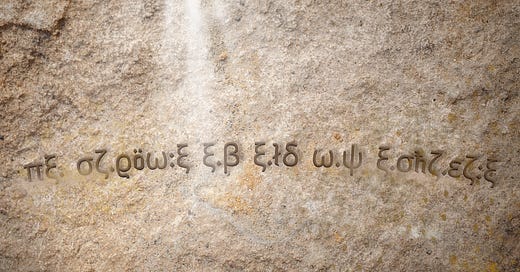Dive Into the Unknown: The Lost Language of Terävæli
How an ancient language was erased—but never truly forgotten
According to historians, the Terävæli language once stood as the cornerstone of fae civilization, an intricate and precise script woven into the fabric of governance, scholarship, and mystical practice. Linguistic analysis of recovered texts suggests that Terävæli was not merely a tool for communication but a language imbued with power, its symbols and phonetics intricately linked to the arcane forces the fae sought to master. Its origins trace back to an ancient root language that predates even the earliest known mortal scripts, exhibiting structural parallels with long-extinct dialects of the ancient world.
Scholars assert that Terävæli evolved under the meticulous stewardship of the Society of Alchemists. The script itself, characterized by sweeping curves, delicate diacritics, and complex ligatures binding multiple phonemes into single glyphs, was designed for more than mere transcription—it was a vessel for esoteric knowledge. This made the language particularly suited for incantations, sigils, and rituals, where precise articulation determined the efficacy of the spell or alchemical transformation.
Artifacts dated to the golden age of Ter Ävæ indicate that the language was deeply embedded in both governance and mystical tradition. Royal decrees, treaties, and legal codes were all inscribed in Terävæli, reinforcing its status as the language of power and control. However, its most profound use was within the clandestine art of alchemy.
While a few rare texts theorizing the ancient alchemical practices have been uncovered, legend maintains that the Society of Alchemists never committed their most powerful secrets to parchment. Instead, they relied on an unbroken chain of verbal transmission, passing their sacred knowledge from master to apprentice in spoken word alone. This oral tradition ensured that only the most devoted acolytes were entrusted with the full breadth of alchemical wisdom, rendering it nearly impossible for outsiders to decipher the true extent of their craft. Recovered relics suggest that certain phonetic shifts within the language corresponded to elemental affinities, a linguistic structure that allowed practitioners to harness and manipulate arcane ability.
Despite its once-universal presence, Terävæli began its decline in the year 8891, following the overthrow of the last great fae king, Alrekur XII. With his fall, the empire fractured into six independent kingdoms, each gradually adopting the common tongue to facilitate trade, governance, and diplomacy. Over time, Terävæli faded from daily use, relegated to the archives of scholars and the whispered rituals of the few who still preserved its teachings. While remnants of its script can still be found etched into the ruins of the old empire, its full meaning is now comprehended by only a handful of dedicated historians and elite tutors who charge exorbitant fees to instruct the offspring of the ruling class in its intricacies.
Scholars continue to debate whether Terävæli’s decline was solely a consequence of political upheaval or if a deliberate effort was made to erase its influence. Some argue that the rulers of the fractured kingdoms viewed the language as a relic of oppression, a lingering shadow of a centralized power they no longer wished to acknowledge. Others suggest that the loss of fae influence rendered the language obsolete, and its once-essential role diminished in the new world order.
Yet, in certain circles, efforts to revive Terävæli persist. Whether out of scholarly fascination or a relentless pursuit of lost knowledge, a select few endeavor to reconstruct its lexicon, piecing together its phonetics and syntactical structures from fragmented records. Each newly deciphered text brings those scholars one step closer to unlocking the full depth of this enigmatic tongue.
Whether Terävæli will remain a relic of the past or find new life in the modern era remains to be seen.
Vaelora, Idris. The Lingua Arcana: A Study of Terävæli and Fae Alchemical Traditions. Archivum Arcanum Press, 17321.




